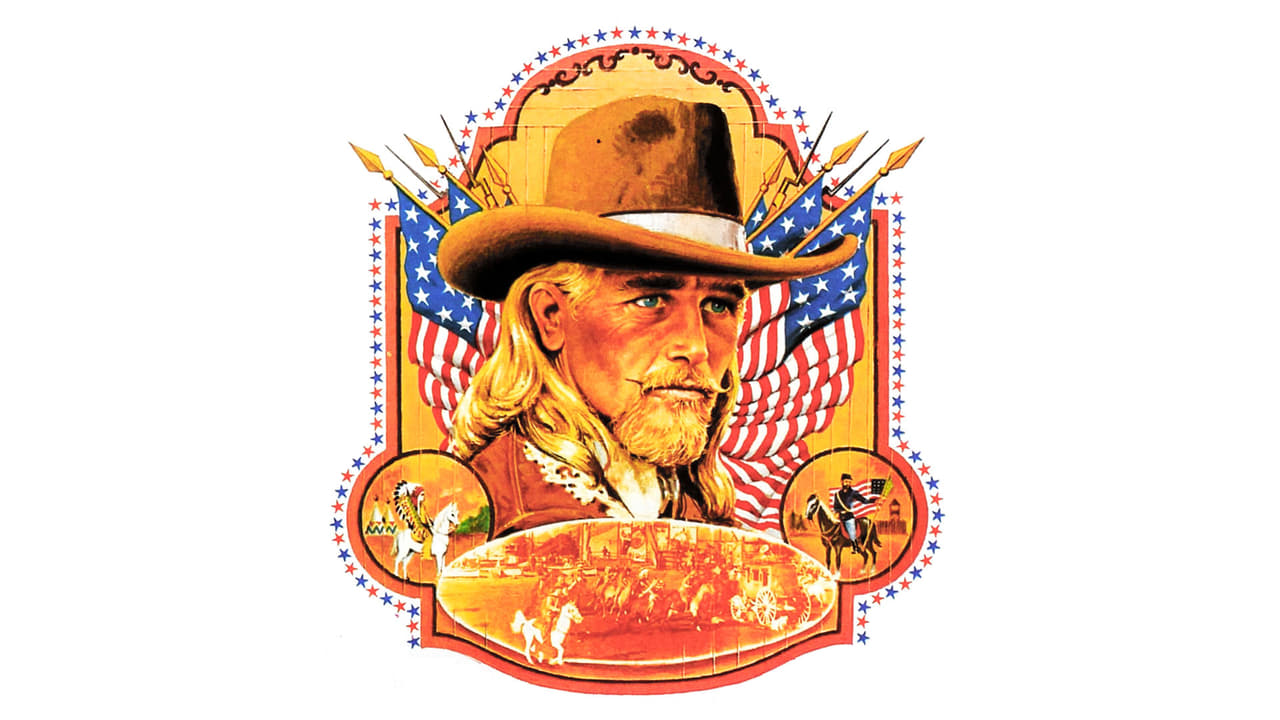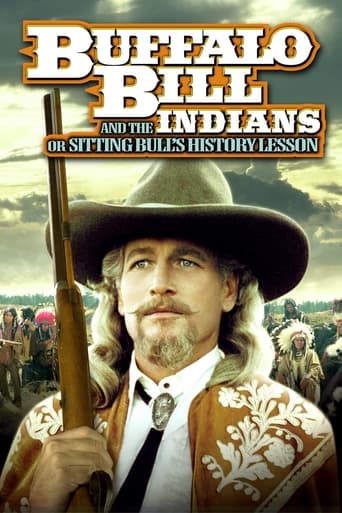



Watch something else. There are very few redeeming qualities to this film.
View MoreExcellent and certainly provocative... If nothing else, the film is a real conversation starter.
View MoreThe film's masterful storytelling did its job. The message was clear. No need to overdo.
View MoreClose shines in drama with strong language, adult themes.
View MoreReleased in 1976 and directed by Robert Altman, "Buffalo Bill and the Indians, or Sitting Bull's History Lesson" stars Paul Newman as Buffalo Bill Cody, the star of his famous "Wild West Show" in the shadow of the Rockies in 1885. After Chief Sitting Bull of Little Big Horn fame (Frank Kaquitts) arrives with his Number One (Will Sampson), Cody is irked that the chief isn't a slaughtering savage, but is silently heroic and honorable. Cody fires him, but relents when star attraction Annie Oakley (Geraldine Chaplin) sympathizes with Sitting Bull. Then President Grover Cleveland (Pat McCormick ) visits with his entourage.This is revisionist Western, a "message movie" that Altman uses to criticize popular ideas or myths about the Old West. The titular hero is merely a showbiz creation who can no longer differentiate the truth from his made-up image. He's a blustering fool who asserts to be one with the Wild West, but lives in extravagance, play-acting in his Western circus. His hair is fake, he can no longer shoot straight or track a Native; and all his theatrical duels with owlhoots and Indians are fixed in his favor.The theme is interesting and the ensemble cast is great (which also includes Burt Lancaster, Kevin McCarthy, Harvey Keitel, John Considine, Noelle Rogers, Shelley Duvall and Denver Pyle, amongst other notables). It should've worked, but it didn't. It's somewhat akin to "Little Big Man" (1970) but less of a comedy and nowhere near as entertaining (not that I'm a big fan of that movie or anything, but at least it has its entertaining moments). While the Wild West circus elicits some entertaining moments (e.g. rodeo stunts) they can't save the flick from being an arty, pretentious, tiresome bomb. Moreover, the principle Native Americans are ironically so one-dimensional and wooden I thought maybe Altman was making a snide aside about "wooden Indians."Lastly, the ideology is blatantly one-sided against the New Americans, depicting Not-as-New Americans as super-noble while conveniently ignoring their documented dark side, e.g. the heinous torture tactics most tribes inflicted on their captive enemies, including other tribes-people, so as to hinder their condition in the afterlife (the "happy hunting grounds" or whatever). For instance, they'd gouge out enemies' eyes or mutilate their genitals so they (supposedly) wouldn't be able to see or copulate in the after-world. Yup, that's just so virtuous (sarcasm). Actually, I could handle this lopsided perspective if the movie itself were entertaining, but that's hardly the case. The film runs 123 minutes and was shot in Alberta, Canada, mostly at Stoney Indian Reserve.GRADE: D
View MoreA film that divides critics equally, Robert Altman's 1976 offering is a clunky movie that fails to sparkle and delivers far less than it should. Flowing haired Paul Newman plays the titular hero, and the premise centres around his Wild West sideshow and his attempts to lure the legend that is white-American nemesis Sitting Bull into the show ring. Meanwhile, the great red Indian chief secretly has his own agenda, and the stand off comes in Newman sacrificing historical fact for blatant commercialism whilst Sitting Bull wants his opportunity to put the record straight on behalf of him and his people. Altman went on record and denied any deliberate political allegory, but there is certainly plenty of evidence to suggest otherwise. The main problem with the movie for me is that a Wild West sideshow with the chief protagonists turned into circus acts just doesn't work. And whilst Gerladine Chaplin is highly watchable as Annie Oakley, with her breathtaking shooting skills ready to go wrong at any minute, there is little to engage the viewer here and it doesn't rise above the mediocre. Newman delivers his lines admirably, and, for such a consummate professional is not inconvenienced by the fact that the movie misfires, but it's too slow in places. He was very similar in WUSA, where he was perfectly able to display his skills with ease whilst all around him was uninspiring, but there are a few too many movies like that in the Newman cannon. This is probably for strict Newman or Altman fans only (unless you really want to spot a youthful looking Harvey Keitel) but you won't be rushing to see this one again and again.
View More"In so far as they cannot be assimilated by modern culture, the wild peoples will have to disappear from the surface of the earth." – Karl KautskyPaul Newman plays Buffalo Bill, a one-time soldier who now runs a successful Wild West Show. Bill hires an Indian warlord called Chief Sitting Bull to guest star in his show, but to Bill's annoyance Sitting Bull proves to be a decent and honourable old man rather than a murderous savage.Bill attempts to get Sitting Bull to re-enact various battles between cowboys and Indians, but Sitting Bull refuses to be portrayed as a caricature. Rather than act out Custer's Last Stand as a cowardly sneak attack initiated by red skins, Sitting Bull instead requests to portray the massacre of a peaceful Sioux community by marauding US Cavalry soldiers. What follows is a battle of myths. Sitting Bull wants to portray his people as the victims of genocide, whilst Bill hopes to portray himself (and by extension the history of White American settlers) as a noble hero and the natives as brutal savages in need of either expulsion or civilization. Bill's history is wrong, of course, but he is the victor as he owns the show, controls the money and knows exactly what his white audience wants. His myth gets printed.And so these various themes – politics, show-business, the commodification of history, the blurring of fact and myth – play out in typical Altman fashion. And like most of Altman's films, this is a giant ensemble piece which takes place in a self-contained environment (the ropey confines of a Wild West Show). Elsewhere Altman's camera glides through his landscape, floating from character to character, various narrative strands gently picked up and followed. It's a graceful sort of film-making, Altman less concerned about delivering spectacle, than gently exposing the conditions under which such spectacle thrives. On the most basic level Altman deconstructs Old West iconography, presenting the cowboy as a show-biz creation who is himself duped by the very myths he bolsters. Altman's Buffalo Bill wears a wig, can't shoot straight, can't ride a horse and requires all his mock battles to be rigged in his favour, and yet he's constantly proclaiming himself to be a grand hero and seasoned man of the west. The film's great joke is that we the audience are so seduced by Paul Newman's star persona, his charisma, the way he commands his on screen lackeys, that we don't quite notice how much of a bumbling idiot he is. The film's characters go out of their way to illustrate this mightily confused blurring of reality and illusion. Altman makes us aware that his film is populated by mere actors and implies that both the personal and show business personae of Buffalo Bill are equally fraudulent. As such, Bill is constantly looking at reflections or portraits of himself, his personality always distorted. Altman also exposes the symbiotic relationship between show business and politics. Upon seeing President Cleveland, Bill exclaims "There's a star!" and of Sitting Bull he says, "If he wasn't interested in show business he wouldn't be a chief!" Later it is revealed that President Cleveland consults an aid before speaking and that Bill has someone else write all his material, both men the unwilling orators of a national myth. Altman then implicates both the audience and the public in the writing of both history and show business. "Truth is that which gets the most applause," one character correctly remarks. The show that is most seen, most palatable, most digested by the masses, is the show that is embraced as historical fact. Nations are built on noble lies, Altman says, and art exists to either propagate or challenge these national myths. This is made most direct when, in the film's final scene, Bill studies a portrait of himself on a white stallion. "Is he sitting on that horse right?" Bill asks, then turns to the camera. "If he's not sitting on that horse right, how come you all took him for a king?" Altman's point is clear. The facts, the cinematic clues, that Buffalo Bill was a fraud were always there. We just chose not to look. The implication is that seeing is always a matter of choice, perception a function of the needs of a dominant ideology. Altman is challenging the audience to see the flaws, to see our history and our present as it really is. And so Altman demonstrates that history itself is increasingly becoming another commodity of capitalist economy; history then is not a Truth, but a matter of choice, able to be traded, bought and sold. The resulting alienation from its process of creation and from the interconnection of its events leads to a loss of truth which only performance can replace. Tellingly the film ends with a photograph - a staged event of a staged event - the audience asked to recall an earlier scene in which this shot was composed. Without this prior context, anyone stumbling upon the photograph would assume that a tall and muscular Indian, carefully positioned by Buffalo Bill to draw attention away from the old and timid looking Sitting Bull, is the real deal. It is this loss of context, of objectivity, that Altman is ultimately condemning. History is like a photograph, deliberately composed, and so without context values may be constantly reformulated according to the narrow requirements of the dominant ideology. Compare this to the end of Brian De Palma's "Redacted", in which a soldier's smile is recorded as truth, when in fact it is forced, a lie and masking something far darker. Altman's film amounts to the same thing, though his photograph is then sold and paraded about as political currency.8.9/10 – Masterpiece. See Hany Abu-Assad's "Paradise Now".
View MoreA very weak Altman film, all the weaker because it came out the year after one of Altman's best works: "Nashville." "Buffalo Bill..." is one of the most savagely satiric films from a director known for savage satire. Unfortunately, it's also a one-joke film, whose joke is given away in the first five minutes, leaving the film nowhere to go. Paul Newman plays Buffalo Bill as a complete buffoon, surrounded by yes-men and lackeys. He practically buys ex-Indian chief Sitting Bull for his Wild West show, and what we suffer through is scene after scene of white men making asses of themselves while native American Indians nobly and quietly observe and judge them. It's two hours of smug finger pointing at oblivious Caucasians for raping and pillaging the American frontier.All of Altman's films have the feel of coming together in the editing room, and many times this approach to structure results in inspired moments, but "Buffalo Bill" feels even more than usual like a film without a center. There's no narrative thread to hold it together, so it has a wandering and monotonous quality. Also, it doesn't help that Altman's shooting style is uncharacteristically distant. There are virtually no close-ups in the entire picture, so scene after scene is photographed in medium and long shots. Both the screenplay and the camera keep us at a distance; as a result, we never become engaged in the action.A definitive misfire.Grade: C
View More